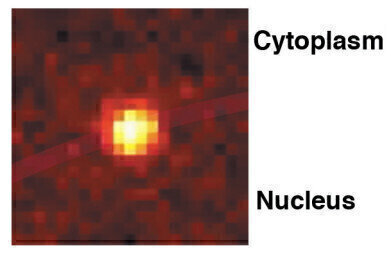Microscopy & Microtechniques
Research Elucidates Individual Steps Controlling Transport Through Nuclear Pore Complex
Nov 16 2011
Nuclear Pore Complexes (NPCs), large protein structures that span the nuclear membrane in eukaryotic cells and mediate the exchange of materials between the nucleus and cytoplasm, play a vital role in many aspects of cellular physiology including gene expression. Defects in NPC function are implicated in a number of autoimmune diseases, leukaemias and others cancers. Also, nuclear transport plays a pivotal role in viral infections. However, it has been unclear how the NPC facilitates the selective translocation of macromolecules.
Now, a team from the University of California, Berkeley, has shed light on the step-by-step process of capture, filtering, translocation and release. Signals from single, protein-functionalised quantum dots cargos were captured by an Andor iXon camera in a custom-built near- TIR (total internal reflection) microscope as they tracked through human NPCs. This showed that the overall selectivity of the NPC arises from the cumulative action of multiple, reversible sub steps and a final, irreversible exit step.
“With their extraordinary photostability and brightness, quantum dots have established themselves as very useful tools for cellular analysis,” said Karsten Weis, Berkeley. “Because of their relatively large size, which is comparable to viral particles, the transport of quantum dots across the NPC is quite slow. This, in combination with their photostability, allowed us real-time tracking over extended periods of time and reconstruction of NPC transport events into high-precision transport trajectories.
“Tracking of single dots places real demands on detector technology to perform at significantly higher levels of sensitivity and speed. Electron Multiplying CCD (EMCCD) technology, as seen in the Andor iXon camera, amplifies down to single photons and is ideal for these studies,” concludes Weis. According to Mark Browne, Director of Systems at Andor, “The Andor iXon offers the highest sensitivity from a quantitative scientific digital camera, particularly at fast frame rates. Plus, Andor’s proven UltraVac™ vacuum technology ensures both deep cooling and complete protection of the sensor while Andor iCam software enables market-leading exposure switching.”
Digital Edition
Lab Asia 31.2 April 2024
April 2024
In This Edition Chromatography Articles - Approaches to troubleshooting an SPE method for the analysis of oligonucleotides (pt i) - High-precision liquid flow processes demand full fluidic c...
View all digital editions
Events
May 05 2024 Seville, Spain
InformEx Zone at CPhl North America
May 07 2024 Pennsylvania, PA, USA
May 14 2024 Oklahoma City, OK, USA
May 15 2024 Birmingham, UK
May 21 2024 Lagos, Nigeria












.jpg)





